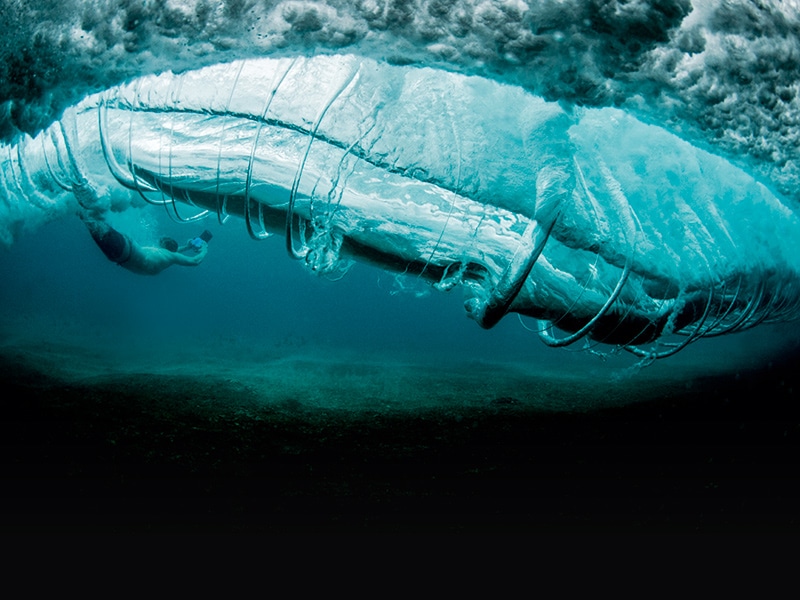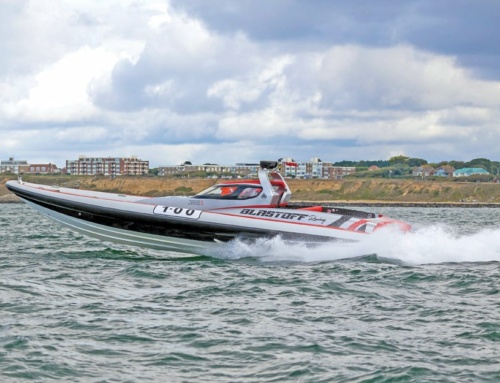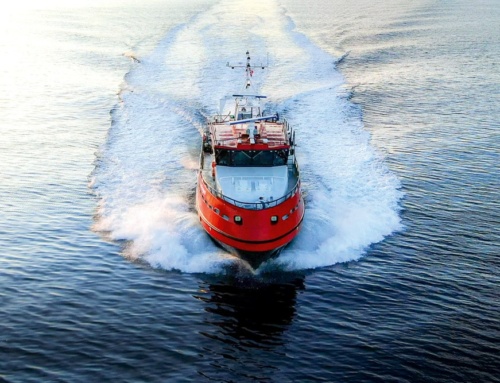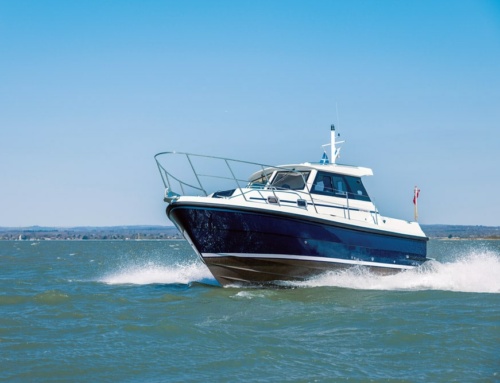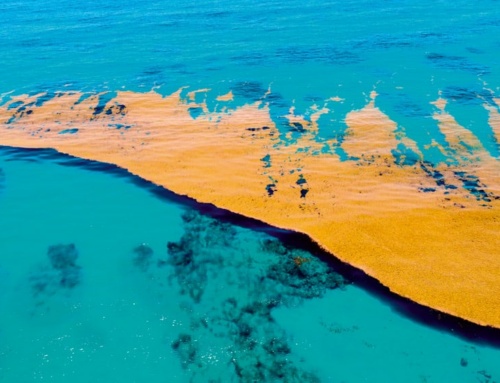- Unlike rogue waves, tsunamis, when confronted offshore or on the open ocean, do not present a threat to vessels at sea.
- You may not be aware that the first scientific evidence of the existence of rogue waves wasn’t formally accepted or established until as recently as the 1980s.
- … at their most powerful, some internal waves can sweep nuclear submarines off course, or even force them to the surface like bath toys!
As part of our special multi-feature on waves, HMS discusses some of the biggest and most dangerous waves ever recorded ‒ monstrous seas that have left even the biggest, most capable vessels afloat reeling and hardened men of the sea shaken to the core. These are the waves of your worst nightmares …
Waves are one of earth’s grandest phenomena. These incredible and alluring bodies of water hold a fascination like few other things associated with our blue planet. Indeed, waves resonate with and compel everyone alive, even those who have never been to sea. From the benign to the rogue, waves connect with our ‘instinct’, the human soul, and few other aspects of nature have the power to inspire, to enthral, to intimidate or even terrify in quite the same way as that moving body of liquid we call ‘the wave’.
Beneath & above
In terms of the incredible, did you know, for instance, that there are even such things as underwater waves? Researchers have found these waves, described also as ‘internal waves’, forming at the boundary between two great layers of differing densities of water in a deep ocean trench in the South Pacific known as the Samoan Passage. The forces at play here form 800ft-high waves that rear up and then plunge hundreds of feet down into the dense water on either side of the ocean trench sill. It seems that these underwater or ‘internal’ waves play an important role in the sea’s ability to mix and spread vital nutrients throughout the oceans as they rotate between and around the earth’s poles. It is thought that they also play a role in stimulating global currents and, at their most powerful, some internal waves can sweep nuclear submarines off course, or even force them to the surface like bath toys!
But back on the surface, in 1826, French scientist and naval officer Captain Jules Dumont d’Urville reported waves as high as 108ft (33m) in the Indian Ocean with three colleagues as witnesses, yet he was publicly ridiculed by fellow scientist of the time François Arago. During the Victorian era, it was widely held that no wave could exceed 30ft (9m). Author Susan Casey wrote that much of that disbelief came because there were very few people who had seen a rogue wave, and until the advent of steel double-hulled ships in the 20th century, ‘people who encountered 100ft rogue waves generally weren’t coming back to tell people about it’.
Rogue seas & platforms
You may also not be aware that the first scientific evidence of the existence of rogue waves wasn’t formally accepted or established until as recently as the 1980s. It came with the recording of a ‘rogue wave’ made by the Gorm platform in the central North Sea in 1984. A standout wave was detected here with a wave height of 11m (36ft) in a relatively low sea state. However, the wave that really caught the attention of the scientific community was the digital measurement of the ‘Draupner wave’, a rogue wave that hit the Draupner platform in the North Sea on 1st January 1995. This huge wave clocked a recorded maximum wave height of 25.6m (84ft, peak elevation of 18.5m [61ft]). During that event, as you might imagine, the force of this wave smashing into the platform inflicted a considerable degree of damage on the platform’s upper structure, located far above sea level, and in the process confirmed beyond all doubt that the reading made was wholly accurate.
Unlike rogue waves, tsunamis, when confronted offshore or on the open ocean, do not present a threat to vessels at sea. The only ships lost in the 2004 Asian tsunami, for example, were those located in port. But while there are tsunamis, there can also be megatsunamis. These are single massive waves caused by sudden impact, such as meteor impact or landslides within enclosed or limited bodies of water. With regard to the latter, the most notable and incredible incident occurred off the Alaskan coast on the night of 9th July 1958.
The biggest ever recorded
An earthquake along the Fairweather Fault in the Alaska Panhandle loosened about 40 million cubic yards (30.6 million cubic metres) of rock high above the north-eastern shore of Lituya Bay. This mass of rock plunged from an altitude of approximately 3000ft (914m) down into the waters of Gilbert Inlet. The impact generated a local tsunami that crashed against the south-west shoreline of Gilbert Inlet with such power that it swept completely over the spur of land that separates Gilbert Inlet from the main body of Lituya Bay. The wave then continued down the entire length of Lituya Bay, over La Chaussee Spit and into the Gulf of Alaska. The force of the wave removed all the trees and vegetation from elevations as high as 1720ft (524m) above sea level. Millions of trees were uprooted and swept away by the wave. This Alaskan monster is the highest wave ever known.
Lighthouses not spared
At midday on 11th March 1861, the lighthouse atop Eagle Island off the west coast of Ireland was struck by a giant wave that smashed 23 panes of its light room. In the mayhem, the ingressing sea washed some of the lamps down the stairs, wrecking them beyond repair and filling the reflectors with broken glass. But in order to damage this uppermost portion of the lighthouse, the wave had to surmount not only the cliff face measuring 40m (133ft) but also a further 26m (87ft) in order to reach the lighthouse structure itself!
If any of our readers have ever traversed the Irish Sea, out to the infamous Fastnet Rock, they will well appreciate that it is a chillingly isolated and austere place. The rock and its weather-beaten lighthouse appear to rise from the very depths of the ocean to bear the full front of everything the water can unleash at them. It’s perhaps not surprising, then, that the lighthouse’s iron shutters, railings and other fittings have been outrageously twisted and mangled by the force of the seas clawing at them. When, in 1985, the Fastnet lighthouse was struck by a 47m-high (154ft) wave, the shock loadings on the structure must have been absolutely incredible, and it’s hard to imagine how this man-made structure could ever have survived such an impact. Trying to envisage this lonely and exposed sea area during such a terrifying storm is the stuff of nightmares.
High seas & ocean liners
During the war years, in 1942, while operating as a troopship carrying 16,082 United States Army servicemen, the British passenger liner RMS Queen Mary was broadsided during a gale by a 92ft (28m) wave, 608 nautical miles (700 mi/1,126km) off the Scottish coast. As a consequence, she very nearly capsized. The vessel listed briefly about 52 degrees before slowly righting herself. Nevertheless, if another sea had struck her in quick succession, it’s more than reasonable to assume that the Queen Mary would never have stood a chance. The resulting loss of life doesn’t bear thinking about.
Now roll forward 50 years to the time of the Queen Mary’s successor, RMS Queen Elizabeth 2, where we learn of another, equally dramatic incident occurring again in the North Atlantic. It’s September 1995 and Hurricane Luis is screaming its way in full fury across the ocean, advancing every nail-biting hour, ever closer to the QE2’s position. As the storm strikes and the waves begin to tear into the ship’s high sides, her master reports seeing a vast wave, which he describes as ‘coming out of the darkness from nowhere’ ‒ a sea so vast that he said it ‘looked like the white cliffs of Dover!’ Newspaper reports at the time described the cruise liner attempting to ‘surf’ the nearly vertical 29m (95ft) wave in order not to be overwhelmed by its sheer immensity. The ship survived, but it was badly shaken and made port having sustained more than a little damage.
The luxury cruise ship Norwegian Dawn reported a three-waves-in-succession incident off the coast of Georgia on 16th April 2005. The crew had reported that the sea had actually calmed down considerably following the height of the storm when a 21m (69ft) wave seemed to come out of ‘thin air’: ‘Our captain, who has 20 years’ offshore experience, said he’d never seen anything like it!’ The resulting enquiry noted that the seawater had exerted so much force that it sheared off the welds to the aluminium rail supports on the ninth- and tenth-level balconies of at least two cabins. This allowed the teak balcony rails to break loose and crash into the cabin windows. The broken glass then filled the drains and compounded the water damage by allowing a large amount of water to enter the two cabins and damage the carpets in 61 other cabins. It’s likely that if the ship hadn’t been operating at a reduced speed when the three waves hit, the damage to the vessel would have been even more significant.
Of biblical proportions
In virtually every culture around the world, including those civilisations that have no connection with the ocean whatsoever, the account of the great flood of Noah’s day is a common story, and one that has been indelibly forged on the consciousness of human society since the most ancient of times. Whether it be the indigenous Plains Indians of North America, the Aboriginal peoples of the Australian outback, those living in the shadow of the Great Wall of China or the communities living on the shores of the Ganges, they all have their own version of this same, epoch-making event.
Though some of the details may differ, what is common among all the stories told is that the flood was a global flood and involved a vessel that bore a total of eight souls to safety. The Bible’s Book of Genesis, of course, relates the account in detail, but one can only imagine the forces at play when the vast water canopy encapsulating the earth’s then global temperate and stable climate was suddenly broken ‒ exposing the Poles in the process. This would have resulted in a shocking and most dramatic change of temperature. It was not only the immense deluge that was so overwhelming in its power and magnitude that it was sufficient to create whole new seas and oceans, but also the winds created by these massive and instantaneous changes of temperature would surely have been immense too.
Driven by hurricane force storms, the waves surging around the giant ‘survival capsule’ or Ark, it’s not unreasonable to assume, would have been like nothing before or since. Moses, the writer of Genesis, details the dimensions of the Ark, which follows the very same mathematical principles that modern boatbuilders employ today. But essentially, it was a giant rectangular box thought to have a tonnage very similar to that of the Titanic and therefore possessed a likely displacement of about 52,310 tons. But as it only had to ride out the turbulence and drift to safety, its rectangular shape, devoid of bows, along with its titanic tonnage, would have served it well among the vast seas and high waves in which it plied for some five months before it came to rest on the mountains of modern-day Turkey.
Was the Ark, therefore, the greatest wave-riding vessel of them all? It was certainly the most critical vessel ever constructed, for if just one wave had overwhelmed it, the human race would have ceased to exist.
HMS
How are waves measured?
For almost 100 years, oceanographers, meteorologists, engineers and ship designers have used a mathematical system commonly called the ‘Gaussian function’ (or ‘Gaussian sea’ or ‘standard linear model’) to predict wave height. This model assumes that waves vary in a regular way around the average (so-called ‘significant’) wave height. In a storm sea with a significant wave height of 12m (39ft), the model suggests there will hardly ever be a wave higher than 15m (49ft). One of 30m (98ft) could indeed happen – but only once in 10,000 years. This basic assumption was well accepted (and acknowledged to be an approximation). The use of a Gaussian form to model waves has been the sole basis of virtually every text on that topic for the past 100 years.
The difference between tidal waves & tsunamis
A tidal wave is quite a predictable event impacted by the atmosphere. It is a result of the daily tides caused by the imbalanced gravitational influences of the moon, sun and planets. Tidal waves are most pronounced in narrow bays or in rivers along the coast. Because of this, water levels may rise by several feet in a matter of hours. It is also possible that a tidal wave will burn out before it reaches the coast. As a rule, tidal waves follow the currents and are unlikely to cause a landfall in areas of temperate climates or northern countries.
A tsunami, on the other hand, is an extraordinary event. It is a series of waves caused by a rapid, massive displacement of the sea floor or disruption of standing water. The ocean floor may be displaced by an earthquake; landslides moving into oceans, bays or lakes; volcanic eruptions; a crashing asteroid; or underwater explosions, by which the water column is uplifted. But the most common cause for a tsunami is an undersea earthquake. The water above such an event is disturbed so significantly by this uplifting that it creates a surface wave travelling at around 500mph (on average). Because of the diverse causes, a tsunami has the potential to develop anywhere, unlike a tidal wave.
How fast do deep-water waves travel?
A surface gravity wave of 10m in length would typically tend to travel at approximately 1.97m/s, or 4.4mph. Therefore, taking a Pacific Ocean distance of 5,000 miles in width by way of example, it would take 1136.36 hours, or 47.34 days, for a deep-water wave to traverse the Pacific basin. And yes, before you ask, waves really can travel that far!
The speed champions of all waves are tsunamis. They are usually generated by large, rapid movements of the ocean floor caused by earthquakes and are not limited by wind speed. Their speed is limited only by the depth of the ocean along their path. Using the Pacific Ocean once again as an example, at its centre, such waves can reach speeds very close to that of a jet plane, i.e. some 600mph! In a storm situation, where wind speeds are blowing at, say, 55mph, one might expect wave speeds of at least 30mph. One can understand why, therefore, it can be very difficult for even a powered vessel to outrun these types of seas. Likewise, when ‘dodging’ or seeking to hold station in a ‘head to sea’ survival situation, with seas advancing at some 30+ mph, the amount of power and fuel required alone to combat such a sea state would be considerable to say the least.
Conditions necessary for a fully developed sea at given wind speeds, and the parameters of the resulting waves
Wind conditions
Wind speed in one direction:
19km/h (12mph) / 37km/h (23mph) / 56km/h / (35mph) / 74km/h (46mph) / 92km/h (57mph)
Fetch:
19km (12 mi) / 139km (86 mi) / 518km / (322 mi) / 1,313km (816 mi) / 2,627km (1,632 mi)
Wind duration:
2hr / 10hr / 23hr / 42hr / 69hr
Wave size
Average height:
| 0.27m (0.89ft) / 1.5m (4.9ft) / 4.1m / (13ft) / 8.5m (28ft) / 14.8m (49ft) |
Average wavelength:
8.5m (28ft) / 33.8m (111ft) / 76.5m (251ft) / 136m (446ft) / 212.2m (696ft)
Average period and speed:
3.0 sec, 10.2km/h (9.3ft/sec) / 5.7 sec, 21.4km/h (19.5ft/sec) / 8.6 sec, / 32.0km/h (29.2ft/sec) / 11.4 sec, 42.9km/h (39.1ft/sec) / 14.3 sec, 53.4km/h (48.7ft/sec)
Note: Most of the wave speeds calculated from the wavelength divided by the period are proportional to the square root of the wavelength. Thus, except for the shortest wavelength, the waves follow the deep-water theory. The 28ft-long wave must be either in shallow water or intermediate depth.

